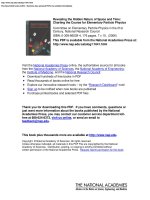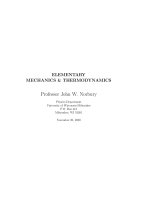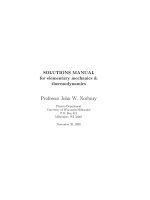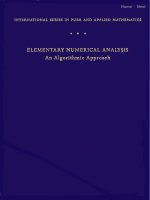Elementary diff eqs 6e earl rainville
Bạn đang xem bản rút gọn của tài liệu. Xem và tải ngay bản đầy đủ của tài liệu tại đây (8.56 MB, 543 trang )
Elementary Differential Equations
www.pdfgrip.com
Elementary
Dijferential
Equations
Sixth Edition
Earl D. Rainville
Late Professor of Mathematics
University of Michigan
Phillip E. Bedient
Professor of Mathematics
Franklin and Marshall College
Macmillan Publishing Co., Inc.
New York
Collier Macmillan Publishers
London
www.pdfgrip.com
Copyright© 1981, Macmillan Publishing Co., Inc.
Printed in the United States of America
All rights reserved. No part of this book may be reproduced
or transmitted in any form or by any means, electronic or
mechanical, including photocopying, recording, or any
information storage and retrieval system, without permission
in writing from the Publisher.
Earlier editions copyright© 1949 and 1952, © 1958, and
copyright© 1964, 1969 and 1974 by Macmillan Publishing
Co., Inc. Some material is from The Laplace Transform:
An Introduction, copyright© 1963 by Earl D. Rainville.
Macmillan Publishing Co., Inc.
866 Third Avenue, New York, New York 10022
Collier Macmillan Canada, Ltd.
Library of Congress Cataloging in Publication Data
Rainville, Earl David,
Elementary differential equations.
Includes index.
1. Differential equations. I. Bedient, Philip
joint author. II. Title.
Edward,
QA371.R29 1980
515.3'5
80-12849
ISBN 0-02-397770-1
Printing: 12345678
Year: 12345678
www.pdfgrip.com
Preface
to the Sixth Edition
This new edition of Professor Rainville's book maintains the simple and
direct style of earlier editions and makes some modest changes. The balance
between developing techniques for solving equations and the theory necessary to support those techniques is essentially unchanged. However, the
variety and number of applications has been increased and placed as early
in the text as is feasible.
The material is arranged to permit great flexibility in the choice of topics
for a semester course. Except for Chapters l, 2, 5, 16 through 18, and either
6 and 7 or 11 and 12, any chapter on ordinary differential equations can be
omitted without interfering with the study of later chapters. Parts of chapters
can be omitted in many instances.
For a course that aims at reaching power series as rapidly as is consistent
with some treatment of more elementary methods, a reasonable syllabus
should include Chapters 1 and 2, Chapters 5, 6, 7, 8, parts of Chapters 13
and 15, Chapters 17 and 18. and whatever applications the instructor cares
to insert.
www.pdfgrip.com
v
vi
Preface to the Sixth Edition
Chapters 1 through 16 of this book appear separately as A Short Course
in Differential Equations, Sixth Edition. The shorter version is intended for
courses that do not include discussion of infinite series methods.
The author wishes to thank those students and colleagues at Franklin
and Marshall College whose suggestions and support have been most helpful.
Phillip E. Bedient
Lancaster, Pennsylvania
www.pdfgrip.com
Contents
1
Definitions, Elimination of Arbitrary Constants
1.
2.
3.
4.
2
Examples of differential equations
Definitions 3
The elimination of arbitrary constants
Families of curves 10
5
Equations of Order One
5.
6.
7.
8.
9.
10.
11.
The isoclines of an equation 16
An existence theorem 19
Separation of variables 20
Homogeneous functions 25
Equations with homogeneous coefficients
Exact equations 31
The linear equation of order one 36
www.pdfgrip.com
27
vii
viii
Contents
12. The general solution of a linear equation
Miscellaneous exercises
3
39
42
Elementary Applications
13.
14.
15.
16.
17.
Velocity of escape from the earth 45
Newton's law of cooling 47
Simple chemical conversion 48
Logistic growth and the price of commodities
Orthogonal trajectories 57
53
4 Additional Topics on Equations of Order One
18.
19.
20.
21.
22.
23.
5
Integrating factors found by inspection 61
The determination of integrating factors 65
Substitution suggested by the equation 70
Bernoulli's equation 72
Coefficients linear in the two variables 75
Solutions involving nonelementary integrals 80
Miscellaneous exercises 82
Linear Differential Equations
24. The general linear equation 84
25. Linearindependence 85
26. An existence and uniqueness theorem 86
27. The Wronskian 86
28.
29.
30.
31.
32.
6
General solution of a homogeneous equation
89
General solution of a nonhomogeneous equation 91
Differential operators 92
The fundamental laws of operation 95
Some properties of differential operators 96
Linear Equations with Constant Coefficients
33. Introduction 100
34. The auxiliary equation; distinct roots 100
35. The auxiliary equation; repeated roots 103
36. A definition of exp z for imaginary z 107
www.pdfgrip.com
Contents
37. The auxiliary equation: imaginary roots
38. A note on hyperbolic functions 110
Miscellaneous exercises 114
ix
108
7 Nonhomogeneous Equations: Undetermined Coefficients
39. Construction of a homogeneous equation
from a specified solution
116
40. Solution of a nonhomogeneous equation
41. The method of undetermined coefficients
42. Solution by inspection 127
8
Variation of Parameters
43.
44.
45.
46.
9
Introduction 133
Reduction of order 134
Variation of parameters 138
Solution of y" + y = f(x) 142
Miscellaneous exercises 145
Inverse Differential Operators
47. The exponential shift
146
48. The operator l/f(D) 150
49. Evaluation of [1/f(D)]eax 151
50. Evaluation of (D 2 + a 2 )- 1 sin ax and (D 2
10
Applications
51.
52.
53.
54.
55.
11
119
121
Vibration of a spring 156
Undamped vibrations 158
Resonance 161
Damped vibrations 163
The simple pendulum 168
The Laplace Transform
56. The transform concept
170
www.pdfgrip.com
+ a 2 )- 1 cos ax 152
x
Contents
Definition of the Laplace transform 171
Transforms of elementary functions 172
Sectionally continuous functions 176
Functions of exponential order 178
Functions of class A 181
Transforms of derivatives 183
63. Derivatives of transforms 186
64. The gamma function 187
65. Periodic functions 188
57.
58.
59.
60.
61.
62.
12
Inverse Transforms
Definition of an inverse transform 194
Partial fractions 198
Initial value problems 201
A step function 206
A convolution theorem 213
Special integral equations 218
Transform methods and the vibration of springs
73. The deflection of beams 226
66.
67.
68.
69.
70.
71.
72.
13
223
Linear Systems of Equations
74. Introduction 233
75. Elementary elimination calculus
233
76. First order systems with constant coefficients
77. Solution of a first order system 239
78. Some matrix algebra 240
79. First-order systems revisted 247
80. Complex eigenvalues 256
81. Repeated eigenvalues 261
82. Nonhomogeneous systems 269
83. Arms races 273
84. The Laplace transform 278
14
Electric Circuits and Networks
85. Circuits 284
86. Simple networks
287
www.pdfgrip.com
237
xi
Contents
15
The Existence and Uniqueness of Solutions
87.
88.
89.
90.
91.
92.
16
Preliminary remarks 297
An existence and uniqueness theorem 298
A Lipschitz condition 300
A proof of the existence theorem 301
A proof of the uniqueness theorem 304
Other existence theorems 306
Nonlinear Equations
93.
94.
95.
96.
92.
98.
99.
100.
101.
102.
17
316
Power Series Solutions
103.
104.
105.
106.
107.
18
Preliminary remarks 307
Factoring the left member 308
Singular solutions 311
The c-discriminant equation 312
The p-discriminant equation 314
Eliminating the dependent variable
Clairaut's equation 318
Dependent variable missing 321
Independent variable missing 323
The catenary 326
Miscellaneous exercises 328
Linear equations and power series 330
Convergence of power series 332
Ordinary points and singular points 334
Validity of the solutions near an ordinary point
Solutions near an ordinary point 336
335
Solutions Near Regular Singular Points
108. Regular singular points 347
109. The indicial equation 350
110. Form and validity of the solutions near a regular
singular point 352
111. Indicial equation with difference of roots nonintegral
112. Differentiation of a product of functions 358
113. Indicial equation with equal roots 359
www.pdfgrip.com
352
xii
Contents
114. Indicial equation with equal roots, an alternative 365
115. Indicial equation with difference of roots a positive
integer, nonlogarithmic case
369
116. Indicial equation with difference of roots a positive
integer, logarithmic case
374
117. Solution for large x 379
118. Many-term recurrence relations
119. Summary 388
Miscellaneous exercises
19
Equations to be treated in this chapter 392
The factorial function 392
The hypergeometric equation 393
Laguerre polynomials 395
Bessel's equation with index not an integer 396
Bessel's equation with index an integer 397
Hermite polynomials 399
Legendre polynomials 399
The confluent hypergeometric equation 401
Numerical Methods
129.
130.
131.
132.
133.
134.
135.
21
389
Equations of Hypergeometric Type
120.
121.
122.
123.
124.
125.
126.
127.
128.
20
383
General remarks 403
The increment method 404
A method of successive approximation 406
An improvement on the preceding method 408
The use of Taylor's theorem 409
The Runge-Kutta method 412
A continuing method 415
Partial Differential Equations
136.
137.
138.
139.
Remarks on partial differential equations 419
Some partial differential equations of applied mathematics
Method of separation of variables 422
A problem on the conduction of heat in a slab 427
www.pdfgrip.com
420
Contents
22
Orthogonal Sets
140.
141.
142.
143.
144.
145.
23
Orthogonality 433
Simple sets of polynomials 434
Orthogonal polynomials 435
Zeros of orthogonal polynomials 436
Orthogonality of Legendre polynomials 437
Other orthogonal sets 439
Fourier Series
146.
147.
148.
149.
150.
151.
152.
24
xiii
Orthogonality of a set of sines and cosines 441
Fourier series: an expansion theorem 444
Numerical examples of Fourier series 448
Fourier sine series 457
Fourier cosine series 461
Numerical Fourier analysis 465
Improvement in rapidity of convergence 466
Boundary Value Problems
153. The one-dimensional heat equation 468
154. Experimental verification of the validity
155.
156.
157.
158.
25
Additional Properties of the Laplace Transform
159.
160.
161.
162.
26
of the heat equation 474
Surface temperature varying with time 477
Heat conduction in a sphere 479
The simple wave equation 481
Laplace's equation in two dimensions 484
Power series and inverse transforms 488
The error function 492
Bessel functions 499
Differential equations with variable coefficients
502
Partial Differential Equations; Transform Methods
163. Boundary value problems
503
www.pdfgrip.com
xiv
Contents
164.
165.
166.
167.
168.
The wave equation 508
Diffusion in a semi-infinite solid 510
Canonical variables 513
Diffusion in a slab of finite width 515
Diffusion in a quarter-infinite solid 519
Index
523
www.pdfgrip.com
1
Definitions, Elimination of
Arbitrary Constants
1. Examples of differential equations
In physics, engineering, and chemistry and, increasingly, in such subjects
as biology, physiology, and economics it is necessary to build a mathematical
model to represent certain problems. It is often the case that these mathematical models involve the search for an unknown function that satisfies an
equation in which derivatives of the unknown function play an important
role. Such equations are called differential equations. As in equation (3)
below, a derivative may be involved implicitly through the presence of
differentials. Our aim is to find methods for solving differential equations;
that is, to find the unknown function or functions that satisfy the differential
equation.
The following are examples of differential equations:
dy
(1)
dx =cos x,
d2y
dx2
+k
2
-
y - 0,
www.pdfgrip.com
(2)
1
2
Definitions, Eliminations of Arbitrary Constants
(x 2
+ y 2)dx
- 2xydy
= 0,
au= h2(a 2u + a 1 u)
at
ax 2 ay 2 '
d 2i
1
di
Ldl
+ Rdt + -i
t
c =
a1 v
ax2
+
(ddx2wr 2
d 3x
dy 3
d2y
dx2
a1 v
ay2
dw
xy dx
dx
( dy)
7 dx
d 2y
dt 2
af
x ax
+
3
+w=
d 2x
dt2
0,
= 0,
- 8y
= 0,
(4)
(5)
(7)
(8)
(9)
(10)
= x,
af
+ y ay =
(3)
(6)
= 0,
~ 4xy
+ x dy
+
Ew cos wt,
(Ch.1
(11)
nf.
When an equation involves one or more derivatives with respect to a
particular variable, that variable is called an independent variable. A variable
is called dependent if a derivative of that variable occurs.
In the equation
(5)
i is the dependent variable, t the independent variable, and L, R, C, E, and
w are called parameters. The equation
a1 v
ax2
+
a1 v
(6)
ay2 = 0
has one dependent variable V and two independent variables.
Since the equation
(x 2
+ y 2 ) dx
- 2xy dy
=0
may be written
x2
+ y2
-
dy
2xy- = 0
dx
www.pdfgrip.com
(3)
§ 2)
3
Definitions
or
dx
+ y 2 ) dy - 2xy =
(x 2
0,
we may consider either variable to be dependent, the other being the independent one.
Exercise
Identify the independent variables, the dependent variables, and the parameters in
the equations given as examples in this section.
2. Definitions
The order of a differential equation is the order of the highest-ordered
derivative appearing in the equation. For instance,
d2y
dx2
3
+ 2b (dy)
dx + y =
(1)
0
is an equation of "order two." It is also referred to as a "second-order
equation."
More generally, the equation
F(x, y, y', .. . , y
=0
(2)
is called an "nth-order" ordinary differential equation. Under suitable
restrictions on the function F, equation (2) can be solved explicitly for y<n> in
terms of the other n + 1 variables x, y, y', ... , y<n- 1 >, to obtain
y
(3)
For the purposes of this book we shall assume that this is always possible.
Otherwise, an equation of the form of equation (2) may actually represent
more than one equation of the form of equation (3).
For example, the equation
x(y') 2
+ 4y'
- 6x 2
=0
actually represents the two different equations,
y
,
=
-2
+ J4 + 6x 3
x
or
y'
14 + 6x 3
-2 - '\/~--= ___
x
A function ¢, defined on an interval a < x < b, is called a solution of the
differential equation (3), provided that the n derivatives of the function exist
www.pdfgrip.com
4
(Ch.1
Definitions, Eliminations of Arbitrary Constants
on the interval a < x < b and
cp<">(x) = f(x, cp(x), cp'(x), ... , Â<ã- 1 >(x)),
for every x in a < x < b.
For example, let us verify that
y
=
e1x
is a solution of the equation
d1y
dx 1
dy
+ dx
- 6Y
(4)
= O.
We substitute our tentative solution into the left member of equation (4)
and find that
d1 y
-
dx 1
dy
+- dx
6y
= 4 e 1x + 2 e 1 x
-
6 e 1x
=0,
which completes the desired verification.
All of the equations we shall consider in Chapter 2 are of order one, and
hence may be written
dy
dx
=
f(x,y).
For such equations it is sometimes convenient to use the definitions of elementary calculus to write the equation in the form
M(x, y) dx
+ N(x, y) dy =
0.
(5)
A very important concept in the study of differential equations is that of
linearity. An ordinary differential equation of order n is called linear if it
may be written in the form
d"y
bo(x)-d
x"
d"- 1 y
dy
+ b 1 (x)d----=-1
+ · · · + bn- l (x)-dx + bn(x)y =
x"
R(x).
For example, equation (1) above is nonlinear, and equation (4) is linear.
The equation
x 1 y"
+ xy' + (x 2
-
n 1 )y
= 4x 3
is also linear.
The notion of linearity may be extended to partial differential equations.
For example, the equation
www.pdfgrip.com
§ 3]
5
The elimination of arbitrary constants
is the general first-order linear partial differential equation with two independent variables and
o2w
bo(X, y) OXZ
o2w
o2w
+ b1(X, y) OX oy + hz(X, y) oy2
ow
ow
+ b3(X, y) OX + b4(X, y) oy + bs(X, y)w =
R(x, y)
is the general second-order linear partial differential equation with two
independent variables.
Exercises
For each of the following, state whether the equation is ordinary or partial, linear
or nonlinear, and give its order.
d 2x
+ k2x =
1. dt2
3. (x 2
5. y"'
0.
+ y 2)dx + 2xydy =
- 3y' + 2y = 0.
o2u
7. ax2
o 2u
d2 y
d2 x
9. X dt2 - y dt2 =
11. (x
13.
d4y
8. dx4
0.
di
10. Ldt
C1.
+ y)dx + (3x 2
_
=
-
l)dy = 0.
(~:~r 2(~:r + yw = o.
15. y"
+ 2y' -
Sy= x 2
+ cosx.
Q(x).
6. yy" = x.
o2u
+ 8y2 + oz2
+ P(x)y =
4. y'
0.
=
w(x).
.
+ Ri =
12. x(y") 3
E.
+ (y') 4
dy
14. dx = 1 - xy
16. a da
+ b db
=
-
y = 0.
+y
2
.
0.
3. The elimination of arbitrary constants
In practice, differential equations arise in many ways, some of which we
shall encounter later. There is one way of arriving at a differential equation,
however, that is useful in that it gives us a feeling for the kinds of solutions to
be expected. In this section we shall start with a relation involving arbitrary
constants and, by elimination of those arbitrary constants, come to a differential equation consistent with the original relation. In a sense we start with
the answer and find the problem.
Methods for the elimination of arbitrary constants vary with the way in
which the constants enter the given relation. A method that is efficient for
www.pdfgrip.com
6
Definitions, Eliminations of Arbitrary Constants
[Ch. 1
one problem may be poor for another. One fact persists throughout. Because
each differentiation yields a new relation, the number of derivatives that need
be used is the same as the number of arbitrary constants to be eliminated.
We shall in each case determine the differential equation that is
(a) Of order equal to the number of arbitrary constants in the given
relation.
(b) Consistent with that relation.
(c) Free from arbitrary constants.
EXAMPLE (a):
the relation
Eliminate* the arbitrary constants c 1 and c2 from
+ C2 e3x.
y = C1 e-2x
(1)
Since two constants are to be eliminated, obtain the two derivatives,
y' = -2c 1 e-ix
y" = 4c1
e-2x
+ 3c 2 e 3 X,
+ 9c2 e3x.
(2)
(3)
The elimination of c 1 from equations (2) and (3) yields
y"
+ 2y' =
15c 2 e3 x;
the elimination of c 1 from equations (1) and (2) yields
y'
+ 2y
= 5c 2 e 3 x.
Hence
y"
+ 2y' =
3(y'
+ 2y),
or
y" - y' - 6y
= 0.
Another method for obtaining the differential equation in this example
proceeds as follows : We know from a theorem in elementary algebra that
the three equations (1), (2), and (3), considered as equations in the two unknowns c 1 and c2 , can have solutions only if
e-2x
-y
-y'
-y"
-
e3x
2 e -2x
3 e3x = 0.
4 e-2x
9 e3x
(4)
Since e- 2 x and e 3 x cannot be zero, equation (4) may be rewritten, with the
factors - 1, e - 2 X, and e3 x removed, as
* By differentiations and pertinent legitimate mathematical procedures. Elimination by
erasure, for instance, is not permitted.
www.pdfgrip.com
§ 3)
The elimination of arbitrary constants
y
1
y'
-2
y"
4
7
1
3 = 0
9
from which the differential equation
y" - y' - 6y = 0
follows immediately.
This latter method has the advantage of making it easy to see that the
elimination of the constants c 1 , c2 , .•• , en from a relation of the form
will always lead to a linear differential equation
dny
aodxn
dn-ly
dy
+ aldxn-1 + ... + an-ldx +any= 0,
in which the coefficients a0 , a 1 , . . . , an are constants. The study of such
differential equations will receive much of our attention.
EXAMPLE (b):
Eliminate the constant a from the equation
+ y2 =
(x - a)2
a1.
Direct differentiation of the relation yields
2(x - a)
+ 2yy' =
0,
from which
a= x
+ yy'.
Therefore, using the original equation, we find that
(yy')2
+ y2 =
(x
+ yy')2,
.or
y2 = x 2
+ 2xyy',
which may be written in the form
(x 2
-
y 2)dx
+ 2xydy = 0.
Another method will be used in this example as an illustration of a device
that is often helpful. The method is based upon the isolation of an arbitrary
constant.
www.pdfgrip.com
8
Definitions, Eliminations of Arbitrary Constants
(Ch.1
The equation
+ y2 =
(x - a)2
az
may be put in the form
+ y2
x2
2ax
-
= 0,
or
x2
+ y2
---=
x
2a.
Then differentiation of both members leads to
x(2x dx
+ 2y dy)
- (x 2
+ y 2 ) dx =
x2
0
,
or
(x 2
y 2 )dx
-
+ 2xydy =
0,
as desired.
It is interesting to speculate here about the significance of x = 0 upon the
argument just used. The student should draw a few of the members of this
family of circles and observe what is peculiar about their behavior at x = 0.
EXAMPLE (c):
Eliminate Band IX from the relation
x
= B cos (wt + IX),
(5)
in which w is a parameter (not to be eliminated).
First we obtain two derivatives of x with respect to t:
dx
dt
d2 x
dt 2
-wB sin (wt+ IX),
(6)
-w 2 B cos (wt + IX).
(7)
Comparison of equations (5) and (7) shows at once that
EXAMPLE (d):
Eliminate c from the equation
+ c2 x + 4 =
0.
+ xy') + c 2 =
0.
cxy
At once we get
c(y
www.pdfgrip.com
§ 3)
The eliminations of arbitrary constants
9
Since c =I- 0,
c = -(y
+ xy')
and substitution into the original equation leads us to the result
x3(y')2
+ x2yy' + 4 =
0.
Our examples suggest that in a certain sense the totality of solutions of an
nth-order equation depends on n arbitrary constants. The sense in which this
is true will be stated in Sections 5 and 12.
Exercises
In each of the following eliminate the arbitrary constants.
1.
2.
3.
4;
xsiny + x 2 y = c.
3x 2 - xy 2 = c.
xy 2 - 1 = cy.
cx 2 + x + y 2 = 0.
ANS.
(sin y
+ 2xy) dx + (x cosy + x 2) dy
ANS.
ANS.
ANS.
= 0.
(6x - y 2 ) dx - 2xy dy = 0.
y 3 dx + (xy 2 + 1) dy = 0.
(x + 2y 2 ) dx - 2xy dy = 0.
5. x =A sin (wt+ /3); w a parameter, not to be eliminated.
6. x = c 1 cos wt
7. y =ex
8. y
9.
10.
11.
12.
13.
14.
15.
16.
17.
18.
19.
'":. 20.
21.
22.
23.
24.
25.
+ c 2 sin wt; w a parameter.
+ c2 + 1.
= .mx +!!_;ha
m
ANS.
+w
2
-
x - 0.
ANS.
ANS.
parameter, m to be eliminated.
dzx
dt2
y = xy'
ANS.
+ (y') 2 + 1.
y = xy '
h
+ ---;.
y
y 2 = 4ax.
ANS. 2xdy - ydx = 0.
y = ax 2 + bx + c.
ANS. y"' = 0.
y = C1 + Cz e 3 x.
ANS. y" - 3y' = 0.
y = 4 + c 1 e 3 x.
ANS. y' - 3y = -12.
y = c 1 + c 2 e- 4 x.
ANS. y" + 4y' = 0.
y = C1 ex + Cz e-x.
ANS. y" - y = 0.
y = X + C1 ex+ C2 e-x.
ANS. y" - y = -x.
y = C1 e 2 x + Cz e 3 x.
ANS. y" - Sy' + 6y = 0.
y = x 2 + c 1 e 2 x + c 2 e 3 x.
ANS. y" - Sy' + 6y = 6x 2 - lOx + 2.
y = c 1 ex+ c 2 xex.
ANS. y" - 2y' + y = 0.
y =A e 2 x + Bx e 2 x.
ANS. y" - 4y' + 4y = 0.
y = c 1 e 2 x cos 3x + c 2 e 2 x sin 3x.
ANS. y" - 4y' + 13y = 0.
y = c 1 e•x cos bx + c 2 e•x sin bx; a and bare parameters.
ANS. y" - 2ay' + (a 2 + b 2 )y = 0.
y = c 1 x + c 2 ex.
ANS. (x - l)y" - xy' + y = 0.
y = c 1 x 2 + c 2 e-x.
ANS. x(x + 2)y" + (x 2 - 2)y' - 2(x + l)y = 0.
y = x 2 + c 1 x + c 2 e-x.
ANS. (x + l)y" + xy' - y = x 2 + 2x + 2.
Y = c 1 x 2 + c 2 e 2 x.
ANS. x(l - x)y" + (2x 2 - l)y' - 2(2x - l)y = 0.
www.pdfgrip.com
10
[Ch.1
Definitions, Eliminations of Arbitrary Constants
4. Families of curves
An equation involving a parameter, as well as one or both of the coordinates of a point in a plane, may represent a family of curves, one curve
corresponding to each value of the parameter. For instance, the equation
(x - c) 2
+ (y
- c) 2
=
(1)
2c 2 ,
or
x2
+ y2
-
2c(x
+ y) =
(2)
0,
may be interpreted as the equation of a family of circles, each having its
center on the line y = x and each passing through the origin. Figure 1 shows
several elements, or members, of this family.
y
FIGURE 1
If the constant c in equation (1) or in equation (2) is treated as an arbitrary
constant and eliminated as in the preceding section, the result is called the
differential equation of the family represented by equation (1). In this example,
the elimination of c is easily performed by isolating c, then differentiating
throughout the equation with respect to x. Thus, from
x2 + y2
x+y
- - - = 2c
we find that
_(x_+_y_)(_2x_d_x_+_2_y_dy_)_-_(x_2 _+_y_2_)(_dx_+_d_y) = 0
(x + y)2
www.pdfgrip.com
.
§ 4)
11
Families of curves
Therefore
(x 2
+ 2xy
- y 2 ) dx - (x 2
-
2xy - y 2 ) dy
=
0
(3)
is the differential equation of the family of circles represented by equation (1).
Note that equation (3) associates a definite slope with each point (x, y) in
the plane
dy
dx
x2
x2
=
+ 2xy
-
- y2
2xy - y 2
(4)
'
except where the denominator on the right in equation (4) vanishes. When
the denominator vanishes, the curve passing through that point must have
a vertical tangent. From
x2
-
2xy - y 2
=0
we see that
y = (-1
+ j2)x
(5)
or
y = ( - 1 - j2)x.
(6)
In Figure 2, the straight lines (5) and (6) appear along with the family (1).
It is seen that the lines (5) and (6) cut the members of the family of circles in
precisely those points of vertical tangency.
y
y=x
y=(-1-J2)x
y=(-1+v'2)x
FIGURE 2
www.pdfgrip.com









